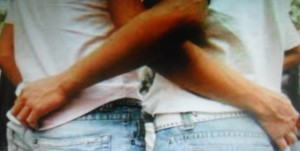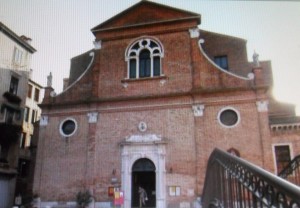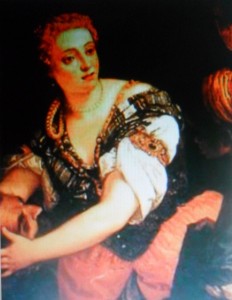Homosexuality in Venice in the Middle Age
The word homosexuality was created by merging the greek word “omoios”, which means
 similar and the Latin word “sexus”, which means ” sex,” and refers to ” a disposition to experience sexual , emotional or romantic attraction to persons of the same sex. ” Homosexuality is found in many animal species. The spread of homosexuality in humans is difficult to determine accurately , although in many ancient cultures homosexual relations were highly prevalent.
similar and the Latin word “sexus”, which means ” sex,” and refers to ” a disposition to experience sexual , emotional or romantic attraction to persons of the same sex. ” Homosexuality is found in many animal species. The spread of homosexuality in humans is difficult to determine accurately , although in many ancient cultures homosexual relations were highly prevalent.
The history of homosexuality is also the story of social attitudes towards a possible behavior perceived as ” deviant “. The social attitude toward homosexual behavior has known moments of relative tolerance , during which the society admitted a certain degree of discussion and public exhibition of the topic, also through art and cultural productions ( for example in classical Athens , Renaissance in Tuscany , or Berlin and Paris before the war ) , however, alternating with moments of harsh repression .
With the birth of the gay movement , you can finally look at this world as a ‘community ‘ structured according to their values and their rituals .But how was seen in the past homosexuality. The male was brought up to be master and ruler in the erotic relationship , and this demanded to be also in the homosexual relationship. When speak about homosexuality at that times, speak almost automatically ,about a relationship between an adult and a boy of age between fourteen and eighteen (remember that at the time puberty came later).
One of the reasons , tacitly accepted even by parents , was “ to be initiated to sexuality, although, in a way felt as a ” surrogate” and certainly not satisfactory . ” The second important reason was the money (very important in a poor society like that .) The money that a guy could add to the family budget from prostitution were not frowned upon by all households and not all parents were willing to ask from where the money came.The third reason was to attract the attention of an adult ( another important aspect when the boy want to have a career) .It was good use among the nobles to agree to take home a “boy ” as roundsman, and in return he could take it to bed without problems.In the Middle Age in Venice were the so-called ” boccia da cullo”.
The Serenissima Republic emits laws, which punish harshly the conduct “against nature” ;the homosexuality .Homosexuals were hanged between the two columns of the St. Mark square, and then burned until “they were reduced to ashes” .A really big blow staged the magistrates of the republic of Venice in 1407: thirty sodomites were discovered and prosecuted. The event , beyond the serious political complications which caused (fourteen defendants were nobles) becomes a great interest for us,because it is one of the first traces of a network of acquaintances among the sodomites in the Italian cities of the Middle Ages .
Mass arrests continue to punctuate the trial papers Venetian for centuries . We find another example already in 1422 : nineteen people involved , including three barbers and several minors , then in 1464 are indicted fourteen people ( including five nobles) , but many of them fleeing before being arrested.On 1474 six sodomites ,two of which nobles co-defendants. The story takes on the hues of a thriller when the accuser is mysteriously murdered.
But by the presence of the homosexuality ,speak to us even the very laws of Venice. One of them, in 1450 , mentions the arcades near the Rialto and the church of St. Martin as meeting places of sodomites . In addition, the Arsenal supervisors, where the church of St. Martin is, decided that ” at the
expense of our Treasury the portico of St.Martin , will be shut with big axis ,doing four doors on all four sides of the columns, which will be opened and closed in accordance with the timetable of the church .
” Five years after this decree , in 1455 , it was decided to patrol certain areas of Venice, to prevent that the sodomites find themselves in their meeting places.In 1488 an edict requires to close with wooden planks the porch of the church of Santa Maria Mater Domini for the same reasons it was already closed St. Martin porch. ” A further list of places “to watch” is drawn in a decree of 1496 , which lists : ” stores, country houses, schools, all the arcades, the houses of scaleteri (bakers), taverns, brothels ,houses of prostitutes . “Some decrees of the “Council of ten” promulgated in the same century , announce , to eradicate ” abhominabile vitium sodomiae . ” Were elected two nobles for only district who had to pick the college of deputies each Friday ,to investigate above the homosexuality . The doctors and barbers, called to treat any man or female, had three days to denounce their “secrets of love “. The members of the patrols will be required to interrogate and investigate if someone manages public places or houses that are called “country houses” (taverns), in which is committed illegal and dishonest acts, or if there are frequent street conversations between not apropriate age friends, ie adults conversing with boys. A new decree , this time to be monitored also scaleteri ( bakers ) , ” because we have been warned the fact that the home of many scaleteri of our city , many young people, and others of different ages and conditions,found by day and by night , and play here and keep tavern, and many commit dishonest acts and sodomy . ”
The most famous , processes, many cases against homosexuals or violence ” against nature” are those against Francesco Cercato who was hanged for sodomy between the columns of the Piazzetta San Marco in 1480 , and that Francesco Fabrizio , priest and poet, who was beheaded and burned in 1545 for the ” unspeakable vice .”The Counter-Reformation, the response to the reform of Martin Luther ( established by the Council of Trent, 1570) had as its purpose to ” imprint a more severe moral and Christian spirit .” The main problem of Venice, a country crossroads of people coming and going throughout the Mediterranean , homosexuality ( a common practice in Venice) was sentenced in Council of Trent .As a result of this reform , the Senate ,decreated that in some places of the city were allowed to put whores who “will showcase their virtues to attract a growing number of men and so firmly maintain the uses of an heterosexual culture“. On the “Carampane area ” , near the Rialto , Venice was one of the areas in which the prostitutes of Venice were forced to concentrate since the fifteenth century to the disposal of public order laws .In 1509 there were 11,654 courtesans in Venice surveyed ( out of a population of 150,000 inhabitants … )
http://dipoco.altervista.org/venice-history-courtesans/
It was not supposed to be easy for sodomites to live peaceful and without guilt . In a world dominated by the church the sin was punished not only by men but also by God.
Despite this, the homosexuality still persists, and occurs especially to young people ,that
could lead to difficulties in socializing and serious consequences for the individual,
including suicide.
other items:http://dipoco.altervista.org/articles/





